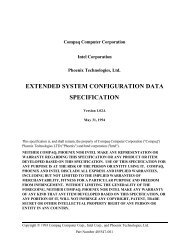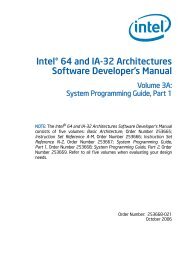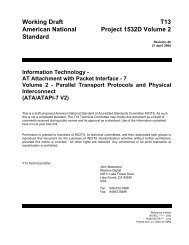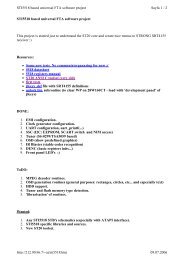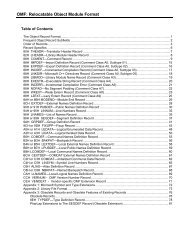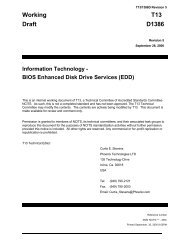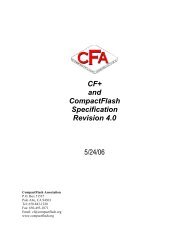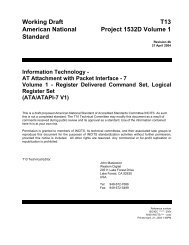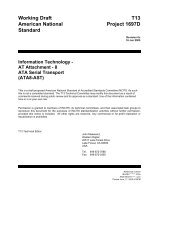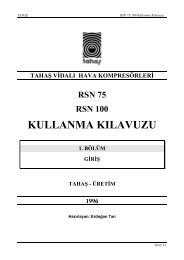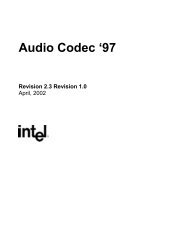Intel 64 and IA-32 Architectures Software Developer's Manual
Intel 64 and IA-32 Architectures Software Developer's Manual
Intel 64 and IA-32 Architectures Software Developer's Manual
Create successful ePaper yourself
Turn your PDF publications into a flip-book with our unique Google optimized e-Paper software.
Documentation Changes<br />
field is 0, then the counter is incremented each cycle by the event count associated<br />
with multiple occurrences.<br />
.. ... ....Text omitted here... ... ....<br />
11. Note defines additional restrictions on APIC DFR programming<br />
In Section 8.6.2.2 of the <strong>Intel</strong> ® <strong>64</strong> <strong>and</strong> <strong>IA</strong>-<strong>32</strong> <strong>Architectures</strong> <strong>Software</strong> Developer’s<br />
<strong>Manual</strong>, Volume 3A, the note has been updated to capture a programming<br />
recommendation. The note is reproduced below. See the change bars.<br />
------------------------------------------------------------------<br />
8.6.2.2 Logical Destination Mode<br />
.. ... ....Text omitted here... ... ....<br />
• The hierarchical cluster destination model can be used with Pentium 4, <strong>Intel</strong> Xeon, P6<br />
family, or Pentium processors. With this model, a hierarchical network can be<br />
created by connecting different flat clusters via independent system or APIC buses.<br />
This scheme requires a cluster manager within each cluster, which is responsible for<br />
h<strong>and</strong>ling message passing between system or APIC buses. One cluster contains up<br />
to 4 agents. Thus 15 cluster managers, each with 4 agents, can form a network of up<br />
to 60 APIC agents. Note that hierarchical APIC networks requires a special cluster<br />
manager device, which is not part of the local or the I/O APIC units.<br />
NOTE<br />
All processors that have their APIC software enabled (using the spurious<br />
vector enable/disable bit) must have their DFRs (Destination Format<br />
Registers) programmed identically.<br />
The default mode for DFR is flat mode. If you are using cluster mode,<br />
DFRs must be programmed before the APIC is software enabled. Since<br />
some chipsets do not accurately track a system view of the logical mode,<br />
program DFRs as soon as possible after starting the processor.<br />
8.6.2.3 Broadcast/Self Delivery Mode<br />
The destination shorth<strong>and</strong> field of the ICR allows the delivery mode to be by-passed in<br />
favor of broadcasting the IPI to all the processors on the system bus <strong>and</strong>/or back to itself<br />
(see Section 8.6.1, “Interrupt Comm<strong>and</strong> Register (ICR)”). Three destination shorth<strong>and</strong>s<br />
are supported: self, all excluding self, <strong>and</strong> all including self. The destination mode is<br />
ignored when a destination shorth<strong>and</strong> is used.<br />
... ....Text omitted here... ... ....<br />
12. Tables documenting MCA error codes updated<br />
Tables 14-15 <strong>and</strong> 14-16 in Section 14.7 of the <strong>Intel</strong> ® <strong>64</strong> <strong>and</strong> <strong>IA</strong>-<strong>32</strong> <strong>Architectures</strong><br />
<strong>Software</strong> Developer’s <strong>Manual</strong>, Volume 3A, have been updated. Information in the tables<br />
is grouped differently. See the change bars below.<br />
-------------------------------------------------------------------<br />
14.7. INTERPRETING THE MCA ERROR CODES<br />
When the processor detects a machine-check error condition, it writes a 16-bit error<br />
code to the MCA error code field of one of the <strong>IA</strong><strong>32</strong>_MCi_STATUS registers <strong>and</strong> sets the<br />
20 <strong>Intel</strong> ® <strong>64</strong> <strong>and</strong> <strong>IA</strong>-<strong>32</strong> <strong>Architectures</strong> <strong>Software</strong> Developer’s <strong>Manual</strong> Documentation Changes




